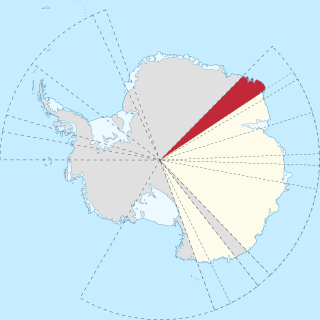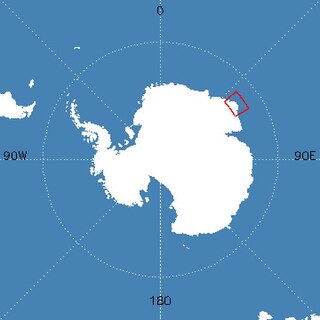Related Research Articles
Beaver Glacier is a glacier about 15 miles (24 km) long and 4 miles (6 km) wide, flowing west into Amundsen Bay between Auster Glacier and Mount Gleadell. The head of Beaver Glacier is located very close to the base of Mount King in Enderby Land. It was visited by an Australian National Antarctic Research Expeditions (ANARE) party on October 28, 1956, and named after the Beaver aircraft used by ANARE in coastal exploration.
White Island is a 24-kilometre-long (13 nmi) and 9-kilometre-wide (5 nmi) ice-covered island in Enderby Land, Antarctica. 15-kilometre-wide (8 nmi) Styles Strait separates it from Sakellari Peninsula. Discovered and called Hvitøya by Hjalmar Riiser-Larsen in January 1930, its existence was considered doubtful for a number of years but was confirmed by the Soviet expedition in the Lena in March 1957, and by ANARE led by D.F. Styles in the Thala Dan in February 1960.
Tange Promontory is an ice-covered peninsula just west of Casey Bay on the coast of Enderby Land in Antarctica. Kirkby Head is a sheer coastal outcrop on Tange Promontory, at the east side of the entrance to Alasheyev Bight.

Enderby Land is a projecting landmass of Antarctica. Its shore extends from Shinnan Glacier at about 67°55′S44°38′E to William Scoresby Bay at 67°24′S59°34′E, approximately 1⁄24 of the earth's longitude. It was first documented in western and eastern literature in February 1831 by John Biscoe aboard the whaling brig Tula, and named after the Enderby Brothers of London, the ship's owners who encouraged their captains to combine exploration with sealing.
John Biscoe was an English mariner and explorer who commanded the first expedition known to have sighted the areas named Enderby Land and Graham Land along the coast of Antarctica. The expedition also found a number of islands in the vicinity of Graham Land, including the Biscoe Islands that were named after him.
The Twelfth Soviet Antarctic Expedition was an expedition by the Soviet Union to Antarctica.

Shinnan Glacier is a glacier which flows northwest to the coast just east of Shinnan Rocks and marks the division between Queen Maud Land and Enderby Land. Mapped from surveys and air photos by Japanese Antarctic Research Expedition (JARE), 1957–62, and named Shinnan Hyōga.
Kichenside Glacier is a glacier, 15 nautical miles (28 km) long and 3 to 5 nautical miles wide, flowing northeast into the southern part of the Hannan Ice Shelf on the coast of Enderby Land, Antarctica. It was charted from air photos taken from an Australian National Antarctic Research Expeditions aircraft in 1956, and was named by the Antarctic Names Committee of Australia for Squadron Leader James C. Kichenside, RAAF, officer commanding the Antarctic Flight at Mawson Station in 1960.
Assender Glacier is a glacier flowing west into Spooner Bay in Enderby Land, Antarctica. It was plotted from air photos taken from Australian National Antarctic Research Expeditions aircraft in 1956, and named by the Antarctic Names Committee of Australia for Pilot Officer Ken J. Assender, RAAF, pilot at Mawson Station in 1959.
Alasheyev Bight is a bight in the western part of the coast of Enderby Land. Kirkby Head is a sheer coastal outcrop on Tange Promontory, at the east side of the entrance to Alasheyev Bight. Alasheyev Bight was photographed from the air by Australian National Antarctic Research Expeditions in 1956. Plotted in 1957 by the Soviet Antarctic Expedition and named for D.A. Alasheyev, Russian hydrographer.

Mount Elkins, also known as Jökelen is a dark, steep-sided mountain with three major peaks, the highest 2,300 meters (7,500 ft) above sea level, in the Napier Mountains of Enderby Land. Enderby Land is part of East Antarctica, and is claimed by Australia as part of the Australian Antarctic Territory. The mountain was named after Terence James Elkins, an ionospheric physicist with the Australian National Antarctic Research Expeditions at Mawson Station in 1960.
Samuel Enderby & Sons was a whaling and sealing company based in London, England, founded circa 1775 by Samuel Enderby (1717–1797). The company was significant in the history of whaling in the United Kingdom, not least for encouraging their captains to combine exploration with their business activities, and sponsored several of the earliest expeditions to the subantarctic, Southern Ocean and Antarctica itself.
Rippon Glacier is a small glacier located in Kemp Land, East Antarctica. It is close east of Seaton Glacier, flowing southward into Edward VIII Ice Shelf.
Sakellari Peninsula is a large ice-covered peninsula between Amundsen Bay and Casey Bay in Enderby Land, Antarctica. This region was photographed by Australian National Antarctic Research Expeditions (ANARE) in 1956-57 and by the Soviet expedition in the Lena in 1957. Named by the Soviet expedition for Nikolai Sakellari, Soviet scientist and navigator.
Demidov Island is a small island 9.3 kilometres (5 nmi) north of the mouth of Rayner Glacier and 17 kilometres (9 nmi) southwest of the Hydrographer Islands along the coast of Enderby Land. It appears that the island was mapped by both the Australian National Antarctic Research Expeditions and the Soviet expedition in 1957. It was named by the Soviet expedition for Lieutenant Dimitri Demidov of the Russian expedition of 1819–21 under Fabian Gottlieb von Bellingshausen.
Cape Monakov is a cape on the west coast of Sakellari Peninsula, Enderby Land, Antarctica. The region was photographed by the Australian National Antarctic Research Expeditions in 1956 and by the Soviet Antarctic Expedition in 1957. The cape was named by the Soviet expedition after S. Ye. Monakov, a Soviet polar aviator who perished in the Arctic.
The Hydrographer Islands are a prominent group of small islands in the bay just south of Sakellari Peninsula, Enderby Land, Antarctica. They were photographed by the Soviet Antarctic Expedition (Lena) in March 1957, and by the Australian National Antarctic Research Expeditions in December 1957. They were named "Ostrova Gidrografov" by the Soviet expedition.
Khmara Bay is a small bay lying directly south of Zubchatyy Ice Shelf and Sakellari Peninsula, in Enderby Land, Antarctica. It was photographed by the Australian National Antarctic Research Expedition in 1956 and explored by the Soviet Antarctic Expedition in 1957. It was named by Soviet expedition after tractor driver Ivan F. Khmara, who lost his life when his tractor broke through the ice at Mirnyy Station in January 1956.

Cooperation Sea, also called Commonwealth Sea (erratum) or Sodruzhestvo Sea, is a proposed sea name for part of the Southern Ocean, between Enderby Land and West Ice Shelf (85°E), off the coast of MacRobertson Land and Princess Elizabeth Land. It would stretch over an area of 258,000 km². It would be bordered by the Davis Sea on the east, and by another Russian proposal to the 2002 International Hydrographic Organization (IHO) draft, a Cosmonauts Sea to the west.
References
- MacNamara, E. E. (1970) "Some Limnological Observations from Enderby Land, Antarctica" in Limnology and Oceanography pp. 768–75